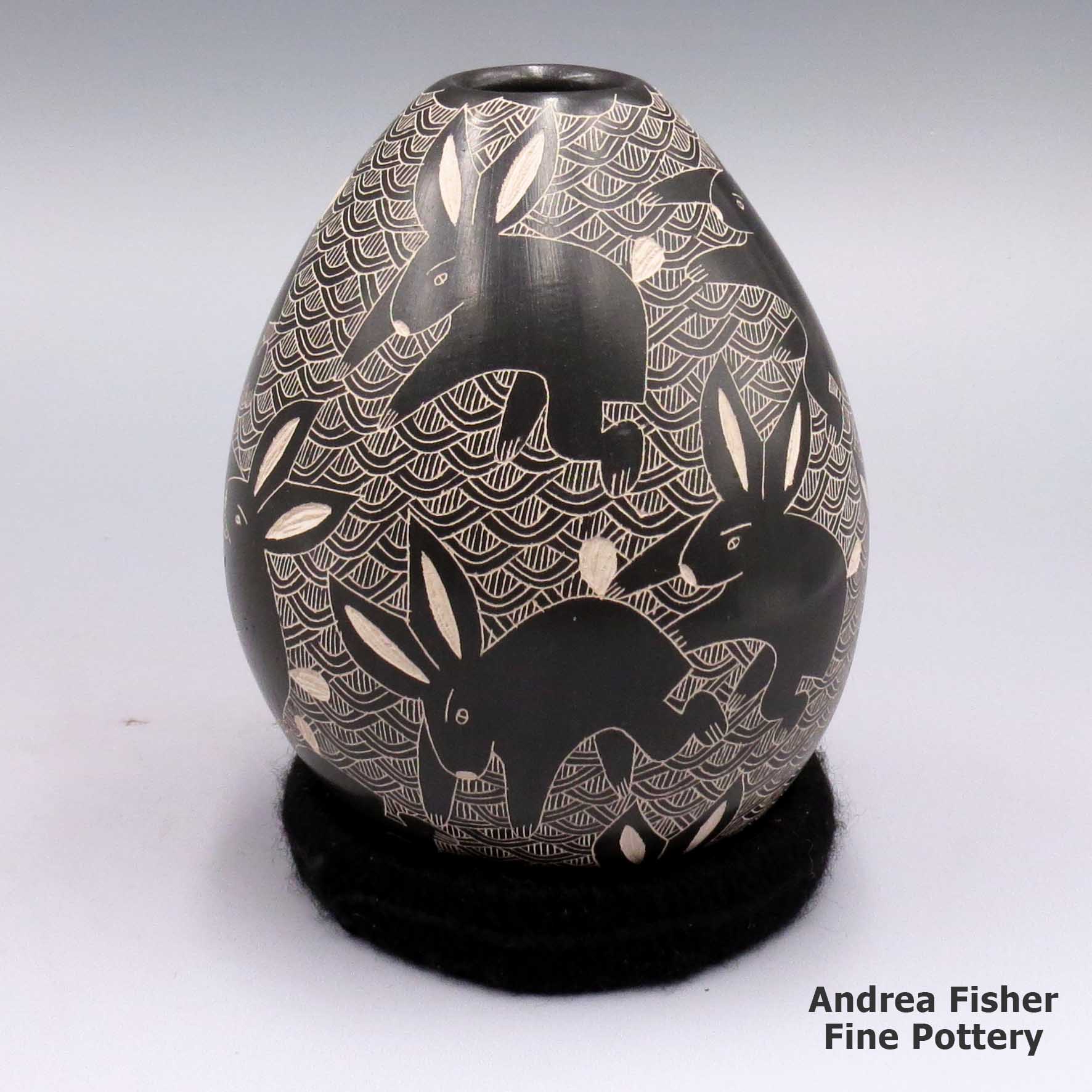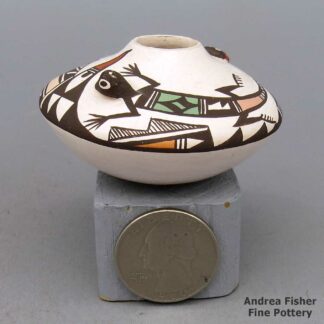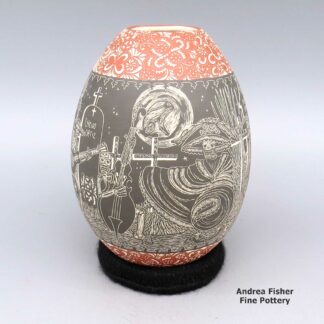| Dimensions | 3.75 × 3.75 × 4.25 in |
|---|---|
| Measurement | Measurement includes stand |
| Date Born | 2022 |
| Signature | Alex Ortega y Vivi Silveira |
Alex Ortega, zzcg2f357m14, Black jar with sgraffito rabbit and geometric design
$150.00
A black-on-white jar decorated with a sgraffito Mimbres rabbit and geometric design
In stock
Brand
Ortega, Alex
They make mostly sgraffito animal, insect, reptile, bird and butterfly designs on mesh backgrounds, usually on black-slipped white-body pots. She used to sign the smaller ones while he signed the larger ones but now they both sign virtually everything they make.
About Mata Ortiz and Casas Grandes
Mata Ortiz is a small settlement inside the bounds of the Casas Grandes municipality, very near the site of Paquimé. The fortunes of the town have gone up and down over the years with a real economic slump happening after the local railroad repair yard was relocated to Nuevo Casas Grandes in the early 1960s. It was a village with a past and little future.
A problem around the ancient sites has been the looting of ancient pottery. From the 1950s on, someone could dig up an old pot, clean it up a bit and sell it to an American dealer (and those were everywhere) for more money than they'd make in a month with a regular job. And there's always been a shortage of regular jobs.
Many of the earliest potters in Mata Ortiz began learning to make pots when it started getting harder to find true ancient pots. So their first experiments turned out crude pottery but with a little work, their pots could be "antiqued" enough to pass muster as being ancient. Over a few years each modern potter got better and better until finally, their work could hardly be distinguished from the truly ancient. Then the Mexican Antiquities Act was passed and terror struck: because the old and the new could not be differentiated, potters were having all their property seized and their families put out of their homes because of "antiqued" pottery they made just yesterday. Things had to change almost overnight and several potters destroyed large amounts of their own inventory because it looked "antique." Then they went about rebooting the process and the product in Mata Ortiz.
For more info:
Mata Ortiz pottery at Wikipedia
Mata Ortiz at Wikipedia
Casas Grandes at Wikipedia
Contemporary Pottery
The term "contemporary" has several possible shadings in reference to Southwestern pottery. At some pueblos, it's more an indicator of a modern style of carving or etching than anything else. At San Felipe it refers to almost anything newly made there as they have almost no prehistoric templates to work from. At Jemez the situation resolved to where what makes a piece uniquely "Jemez" is the clay. Any designs on that clay can be said to be "contemporary."
About Jars
The jar is a basic utilitarian shape, a container generally for cooking food, storing grain or for carrying and storing water. The jar's outer surface is a canvas where potters have been expressing their religious visions and stories for centuries.
In Sinagua pueblos (in northern Arizona), the people made very large jars and buried them up to their openings in the floors of the hidden-most rooms in their pueblo. They kept those jars filled with water but also kept smaller jars of meat and other perishables inside those jars in the water. It's a form of refrigeration still in use among indigenous people around the world.
Where bowls tend to be low, wide and with large openings, jars tend to be more globular: taller, less wide and with smaller openings.
For a potter looking at decorating her piece, bowls are often decorated inside and out while most jars are decorated only on the outside. Jars have a natural continuity to their design surface where bowls have a natural break at the rim, effectively yielding two design surfaces on which separate or complimentary stories can be told.
Before the mid-1800s, storage jars tended to be quite large. Cooking jars and water jars varied in size depending on how many people they were designed to serve. Then came American traders with enameled metal cookware, ceramic dishes and metal eating utensils...Some pueblos embraced those traders immediately while others took several generations to let them and their innovations in. Either way, opening those doors led to the virtual collapse of utilitarian pottery-making in most pueblos by the early 1900s.
In the 1920s there was a marked shift away from the machinations of individual traders and more toward marketing Native American pottery as an artform. Maria Martinez was becoming known through her exhibitions at various major industrial fairs around the country and Nampeyo of Hano was demonstrating her art for the Fred Harvey Company at the Grand Canyon. The first few years of the Santa Fe Indian Market helped to solidify that movement and propel it forward. It took another couple generations of artists to open other venues for their art across the country and turn Native American art into the phenomenon it has become.
Today's jars are artwork, not at all for utilitarian purposes, and their shapes, sizes and decorations have evolved to reflect that shift.
About the Mimbres Culture
The Mimbres culture existed in the Mimbres Valley of southern New Mexico from about 850 CE to about 1150 CE. They were a sub-culture of the greater Mogollon culture that extended from the west coast of Mexico east across the Sierra Madre Mountains, north to the San Andres Mountains and northwest along the Mogollon Rim to the vicinity of today's Springerville, AZ.
North of the Gila Mountains was the influence of the Great Houses of the Chaco culture. Through comparisons of imagery and the colors used, it has been conjectured that Chaco was a more male dominant society while Mimbres was more female dominant. Both areas were settled, built, flowered and abandoned on almost exactly the same time schedules. But at the time of abandonment, the folks of Chaco mostly moved north while those of the Mimbres valley mostly went south.
The Mimbres people were among the first cultures that evolved their own forms of imagery and means of telling stories through those images. The Classic Mimbres period was the height of their creativity, from about 1000 CE to about 1150 CE. Then things changed and migrations began in earnest. Many moved south and brought some of their art to Paquimé. Others pushed north and then west, around the Gila Mountains. By 1200 CE the vast majority of the people in the area of the Mimbres Valley had moved elsewhere.
Most Mimbres pottery was black-on-white. Around 1120 CE there was an influx of migrants from Hohokam and Salado areas to the west. That's about when the first black-on-red pottery appeared in the Mimbres villages. Some of the imagery we see today from many of the Northern and Middle Rio Grande pueblos had its origins in the Mimbres Valley.
Substantial depopulation of the area occurred shortly after 1150 CE but there were many small surviving populations scattered around. Over time, these melted into the surrounding cultures with many families moving north to Acoma, Zuni and Hopi while others moved south to Casas Grande and Paquimé.
The greater Mogollon culture spanned the countryside from the west coast of Mexico east across the Sierra Madre to Paquimé, then north through the Mimbres Valley to the edge of the White Sands and then northwest along the Mogollon Rim into east-central Arizona.
The time period from about 850 CE to about 1000 CE is classed the Late Basketmaker III period across the Southwest. The time period was characterized by the evolution of square and rectangular pithouses with plastered floors and walls. Ceremonial structures were generally dug deep into the ground. In the Mimbres Valley area, local forms of pottery have been classified as early Mimbres black-on-white (formerly Boldface Black-on-White), textured plainware and red-on-cream.
The Classic Mimbres phase (1000 CE to 1150 CE) was marked with the construction of larger buildings in clusters of communities around open plazas. Some constructions had up to 150 rooms. Most groupings of rooms included a ceremonial room, although smaller square or rectangular underground kivas with roof openings were also being used. Classic Mimbres settlements were located in areas with well-watered floodplains available, suitable for the growing of maize, squash and beans. The villages were limited in size by the ability of the local area to grow enough food to support the village.
Pottery produced in the Mimbres region is distinct in style and decoration. Early Mimbres black-on-white pottery was primarily decorated with bold geometric designs, although some early pieces show human and animal figures. Over time the rendering of figurative and geometric designs grew more refined, sophisticated and diverse, suggesting community prosperity and a rich ceremonial life. Classic Mimbres black-on-white pottery is also characterized by bold geometric shapes executed with refined brushwork and very fine linework. Designs may include figures of one or more humans, animals or other shapes, bounded by either geometric decorations or by simple rim bands. A common figure on a Mimbres pot is the turkey, others are the thunderbird, rabbit and various anthropomorphic, half-human figures. There are also a lot of different fish depicted, some are species found only in the Gulf of California (hundreds of miles away across the desert).
A lot of Mimbres bowls (with kill holes) have been found in archaeological excavations but most Mimbres pottery shows evidence it was actually used in day-to-day life and wasn't produced just for burial purposes.
There's a lot of speculation as to what happened to the Mimbres people as their countryside was rapidly depopulated after about 1150 CE. The people of Isleta, Acoma and Laguna find ancient Mimbres pot shards on their pueblo lands, indicating that pottery designs from the Mimbres River area migrated north. There are similar designs found on pot shards littering the ground around Casas Grandes and Paquimé near Mata Ortiz and Nuevo Casas Grandes in northern Mexico. Other than where they went, the only reasons offered for why they left involve at least small scale climate change. The usual comment is "drought" but drought could have been brought on by the eruption of a volcano on the other side of the planet, or a small change in the El Nino-La Nina schedule. Whatever it was that started the outflow of people, it began in the Mimbres River area and spread outward from there. Excavations in the eastern Mimbres region (nearer to Truth or Consequences, New Mexico) have shown that the people adapted to new circumstances and that adaptation itself moved them closer into alignment with surrounding villages and cultures. Eventually they just kind of merged into the background population.
The groups that moved south and built up Paquimé and Casas Grandes became powerful and wealthy over the next couple hundred years. Then they seem to have lost a war in the mid-1400s and the survivors were forced to migrate to the west, to a land a bit more hospitable for them at the time. It's also quite possible that they were defeated by volcanic eruptions on the other side of the planet: the 1100s, 1200s and 1300s were a time of migration in many parts of the world because of continuing bad weather events. The Little Ice Age that saw temperatures in the Northern Hemisphere drop as much as 2°C began in the early 1300s and lasted into the mid 1800s. NASA feels that this was mostly a result of large volumes of volcanic aerosols being pumped into the atmosphere at the time.




